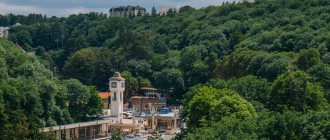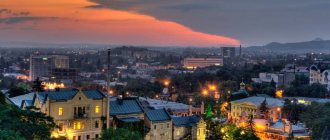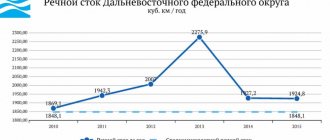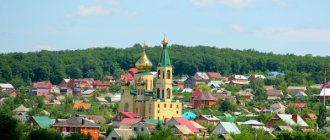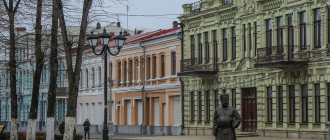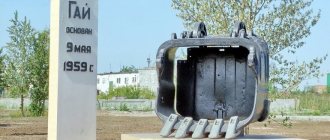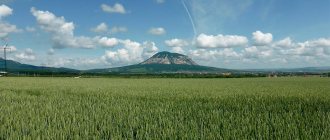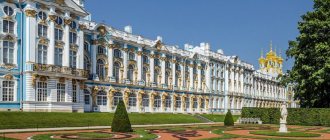City in Stavropol Krai, Russia
| Mineral water Mineral water | |
| Town[1] | |
| Panoramic view of Mineralnye Vody | |
| Coat of arms | |
| Location of Mineralnye Vody | |
| Mineral water Location of Mineralnye Vody Show map of Russia Mineral water Mineralnye Vody (Stavropol Territory) Show map of Stavropol Territory | |
| Coordinates: 44°13′N 43°08′E / 44.217°N Latitude 43.133°E / 44.217; 43.133Coordinates: 44°13′N 43°08′E / 44.217°N Latitude 43.133°E / 44.217; 43.133 | |
| A country | Russia |
| Federal subject | Stavropol region[1] |
| Based | 1878 |
| City status from | 1922 |
| Government | |
| • Head | Konstantin Gamayunov |
| Square [2] | |
| • General | 51.55 km2 (19.90 sq mi) |
| Height | 300 m (1000 ft) |
| population (2010 Census)[3] | |
| • General | 76,728 |
| • Evaluate (2018)[4] | 74,758 (-2.6%) |
| • Classify | 213th in 2010 |
| • Density | 1,500/km2 (3,900/sq mi) |
| Administrative status | |
| • Subordinate | city of regional significance of Mineralnye Vody[1] |
| • Capital from | city of regional significance Mineralnye Vody[1], Mineralovodsky district[1] |
| Municipal status | |
| • Urban district | Mineralovodsky urban district[5] |
| • Capital from | Mineralovodsky urban district[5] |
| Timezone | UTC + 3 (MSK [6]) |
| Postal code(s)[7] | 357200–357205, 357207, 357209, 357210–357212, 357260, 357261, 357265, 357270 |
| Dial code(s) | +7 8792 |
| OKTMO I WOULD | 07721000001 |
| Web site | network.archive.org/ Internet/20120114070232/ https:// www.gorodminvody.RU/ |
Mineralnye Vody (Min-Vody)
(Russian: Mineralnye Vody (Min-Vody), IPA: [mʲɪnʲɪˈralʲnɨjə ˈvodɨ, mʲɪn ˈvodɨ]; lit
mineral waters
) (Chechen: Minvod) is a town in Stavropol Krai, Russia, located along the Kuma River and the main railway line between Rostov-on-Don -Don in Russia and Baku in Azerbaijan. Population: 76,728 (2010 Census);[3]75,644 (2002 Census);[8]70,961 (1989 Census).[9]
Story
The city owes its birth to the construction of the Rostov-Vladikavkaz railway, the construction of which was completed in 1875. In 1878, the village that arose around the construction was officially recognized and named Sultanovsky
. In 1906, the name was changed to Illarionovsky in honor of the local nobleman Count I. I. Vorontsov-Dashkov. In October 1921, at the end of the Civil War, when Soviet power was established, the name was changed again to Mineralnye Vody and city status was granted.[10] About 14,000 people lived in the new city. It was occupied by Nazi Germany from August 10, 1942 to January 11, 1943 during World War II.
Medicine
The question is not easy. There are two hospitals, a city and a railway, a good maternity hospital, a antenatal clinic, as well as several paid specialized medical centers and laboratories for taking tests. Analyzes from all laboratories fly to Moscow and are performed only there... However, Biotest seems to do them in Pyatigorsk. It is quite difficult to get a free voucher to see a specialist, but it is quite possible to make an appointment with the same therapist on the Internet; moreover, you can also make an appointment with other doctors in the CMS region. But the flow of patients is large, and my relatives prefer to go to paid doctors without waiting in line. And a railway hospital is, in fact, the same paid medical center, in which only Russian Railways pensioners and active employees, as well as members of their families, have the right to free treatment.
Administrative and municipal status
As part of the structure of administrative units, Mineralnye Vody serves as the administrative center of the Mineralovodsky District, even though it is not part of it.[1] As an administrative division, it is registered separately as the city of regional significance of Mineralnye Vody
- an administrative unit with a status equal to that of a district.[1]
As a municipal entity, the territories of the city of Mineralnye Vody of regional significance and the city of Mineralovodsk district were included as the Mineralovodsk urban district[5] from June 7, 2015.[11] Before this, the area was part of the Mineralovodsk municipal district, and it included the regional city of Mineralnye Vody. Urban settlement Mineralnye Vody
.[11]
Hot Springs
There is only one hot spring town in the region. What is he famous for?
Zheleznovodsk
The advantage of the resort is its high-temperature springs, unique for Europe, with carbonic sulfate-hydrocarbonate waters of medium mineralization.
There are 16 springs in Zheleznovodsk, the effects of which have been tested by time.
Balneology of the 21st century combines the therapeutic effects of healing waters with modern procedures, enhancing the natural effect.
Climate
The climate of Mineralnye Vody is classified as humid continental (Köppen climate classification DFA
).
| Climate data for Mineralnye Vody | |||||||||||||
| Month | Jan | Feb | Mar | Apr | May | Jun | Jul | Aug | Sep | October | But I | December | Year |
| Record high °C (°F) | 19.5 (67.1) | 21.5 (70.7) | 30.3 (86.5) | 34.5 (94.1) | 34.9 (94.8) | 37.5 (99.5) | 39.7 (103.5) | 41.1 (106.0) | 37.4 (99.3) | 34.1 (93.4) | 25.8 (78.4) | 19.4 (66.9) | 41.1 (106.0) |
| Average high °C (°F) | 1.7 (35.1) | 2.5 (36.5) | 8.4 (47.1) | 16.8 (62.2) | 21.8 (71.2) | 26.5 (79.7) | 29.8 (85.6) | 29.3 (84.7) | 23.9 (75.0) | 16.4 (61.5) | 8.2 (46.8) | 2.8 (37.0) | 15.7 (60.3) |
| Daily average °C (°F) | −2.5 (27.5) | −2.4 (27.7) | 2.9 (37.2) | 10.1 (50.2) | 15.1 (59.2) | 19.6 (67.3) | 22.7 (72.9) | 22.0 (71.6) | 16.8 (62.2) | 10.2 (50.4) | 3.4 (38.1) | −1.3 (29.7) | 9.7 (49.5) |
| Average low °C (°F) | −5.7 (21.7) | −6.1 (21.0) | −1.2 (29.8) | 4.6 (40.3) | 9.2 (48.6) | 13.6 (56.5) | 16.2 (61.2) | 15.7 (60.3) | 11.2 (52.2) | 5.8 (42.4) | 0.2 (32.4) | −4.6 (23.7) | 4.9 (40.8) |
| Record low °C (°F) | −33.3 (−27.9) | −31.6 (−24.9) | −23.8 (−10.8) | −7.6 (18.3) | −2.9 (26.8) | 3.2 (37.8) | 7.5 (45.5) | 4.2 (39.6) | −4.6 (23.7) | −17.7 (0.1) | −23.6 (−10.5) | −31.5 (−24.7) | −33.3 (−27.9) |
| Average precipitation mm (inches) | 18 (0.7) | 18 (0.7) | 28 (1.1) | 54 (2.1) | 66 (2.6) | 86 (3.4) | 69 (2.7) | 48 (1.9) | 35 (1.4) | 38 (1.5) | 31 (1.2) | 28 (1.1) | 519 (20.4) |
| Source: Pogoda.ru.net[12] | |||||||||||||
Treatment
The medical facilities in the KMS sanatoriums are constantly updated and meet all European standards.
Essentuki specializes in the treatment of diseases of the digestive system, liver, metabolic disorders, and biliary tract.
Zheleznovodsk specializes in the treatment of diseases of the digestive system, kidneys, and urinary tract.
Pyatigorsk specializes in the treatment of diseases of the nervous system, blood vessels, musculoskeletal system, digestive organs, skin diseases, vibration disease, and occupational polyneuritis. The resort has radon springs, which have a positive effect in the treatment of the musculoskeletal system.
Kislovodsk specializes in the treatment of circulatory diseases and diseases of the nervous system.
Recommendations
Notes
- ^ a b c d f g gram
Resolution No. 63-r - Office of Rosreestr for the Stavropol Territory. Report on the state and use of lands in the Stavropol Territory in 2010 [ permanent dead link
], paragraph 54 - ^ a b
Federal State Statistics Service of Russia (2011).
“All-Russian Population Census 2010. Volume 1" [All-Russian Population Census 2010, vol. 1]. All-Russian Population Census 2010 [All-Russian Population Census 2010]
(in Russian). Federal State Statistics Service. - "26. The size of the permanent population of the Russian Federation by municipalities as of January 1, 2022.” Federal State Statistics Service. Retrieved January 23, 2022.
- ^ a b c
Law No. 88-kz - "On the calculation of time." Official Internet portal of legal information
(in Russian). June 3, 2011. Retrieved January 19, 2022. - Post office. Information and computing center of OASU RPO. ( Post office
).
Search for postal facilities ( Search for postal facilities
) (in Russian) - Federal State Statistics Service of Russia (May 21, 2004). “The population of Russia, the constituent entities of the Russian Federation as part of federal districts, urban settlements, urban settlements, settlements, settlements is 3 thousand or more people” [Population of Russia, its federal districts, constituent entities of the federation, districts, urban settlements, rural settlements - administrative centers, rural settlements with a population of more than 3000 people] (XLS). All-Russian Population Census of 2002 [All-Russian Population Census of 2002]
(in Russian). - “All-Union Population Census of 1989. The actual population of union and autonomous republics, autonomous regions and districts, territories, regions, urban settlements and villages of Stavropol Pravda,” No. 216, October 6, 2004 (State Duma of the Stavropol Territory. Law No. 88 -KZ dated October 4, 2004 On assigning the status of urban, rural settlement, urban district, municipal district to municipalities
As amended by Law No. 51-KZ dated May 28, 2015
On the transformation of municipal formations within the Mineralovodsk municipal district of the Stavropol Territory (Mineralovodsk territorial municipal formation of the Stavropol Territory) and on the organization of local self-government in the territory of the Mineralovodsky district of the Stavropol Territory
. Valid from the date of official publication.).
Caucasian Mineral Waters
Kavminvody - the name speaks for itself. Famous resort places, the all-Russian balneoclimatic resort of Caucasian Mineral Waters are four cities with their own characteristic features, cozy and attractive.
The healing power of the local mineral springs has long been known to the local population. Legends also tell about this, where truth is intricately intertwined with poetic fiction. An echo of such a legend is also contained in the name of one of the popular local mineral waters - Narzan. This word can be translated into Russian as “heroic drink”, “water of heroes”. Narzan was considered the source of power of the Narts, a tribe that once allegedly lived in the North Caucasus.
The first historical information about the “hot waters” of Pyatigorye dates back to the 14th century and belongs to the Arab traveler Ibn Batuta. Peter I showed scientific interest in them, sending an expedition to study them. However, the information received was soon forgotten. Interest in them was revived again at the end of the 18th century, when the first Russian settlement appeared in these places - the Konstantinogorsk Fortress, built near Mount Mashuk in 1780.
The date of birth of the resort is considered to be 1803, when the national importance of the Caucasian mineral waters was recognized and the study of their medicinal properties began. Settlements appear near the springs. The first such settlement was Goryachevodsk at the foot of Mashuk. In 1830, it was renamed Pyatigorsk - after the name of the nearby five-domed Beshtau Mountain. Then Kislovodsk, Essentuki, Zheleznovodsk arose.
The poetic discovery of the Caucasus belongs to the great Pushkin. The first time he saw the Caucasus was on the waters, where he arrived in 1820 with the Raevskys, heading into exile. And this meeting left an indelible mark on Pushkin’s poetry. He himself wrote about this in his dedication to N. Raevsky for the poem “Prisoner of the Caucasus”:
The Caucasus... Where the cloudy Beshtau, the majestic hermit, the five-headed ruler of the villages and fields, Parnassus was new to me.
Many prominent people have been on the waters. Such great names are associated with Caucasian Mineral Waters as: Odoevsky A.I., Ogarev N.P., Glinka M.I., Rachmaninov S.V., Balakirev M.A., S.I.Taneev, L.V. .Sobinov, Shalyapin F.I., Gorky A.M., Mayakovsky V.V., Yesenin S.A., Repin I.E., Yaroshenko N.A., Tolstoy L.N. But a special place among them belongs to M.Yu. Lermontov.
Lermontov was on the waters several times, first as a child, then during his exile to the Caucasus in the active army. He knew the Caucasus very well, knew the society that gathered on the waters. The novel “Princess Mary” was written based on the impressions of life on the waters. It has complete recognition of cities and their surroundings, characters and types. A gifted painter, Lermontov was one of the first to create a romantic landscape of the Caucasus. In Pyatigorsk, in the 27th year, Lermontov’s life was cut short; he was killed in a duel. A memorial to M. Lermontov was created at the resorts. And in the center of Pyatigorsk, a monument to M. Lermontov was erected in 1889, created by sculptor A. Opekushin with funds raised by subscription.
Today Caucasian Mineral Waters is a recognized balneological resort. Every year at least a million people are treated and rest here. The main wealth of the resort is its mineral springs, unique in their diversity and healing properties, supplemented by deposits of healing mud. Treatment at the resort is carried out strictly on a scientific basis. Each of the resort towns, depending on the composition of the sources and microclimate, specializes in the treatment of various diseases. And all together they bring people health and joy. In the cities of Kavminvod, health resorts with a high level of service have been created; a lot is being done here for the convenience of those who come for treatment and just to relax.
Caucasian Mineral Waters is located in the middle of a seven-hundred-kilometer isthmus between the Black and Caspian seas on the northern slopes of the Main Caucasus Range, just 90 km from the highest mountain in Europe - Elbrus, the double-headed peak of which is clearly visible throughout almost the entire region. Occupying an area of about 6 thousand square meters. km, the region is distinguished by great contrasts in natural conditions.
In the south, in the foothills of Elbrus, there are the valleys of the Khasaut and Malki rivers, in the west - the upper reaches of the Eshkakona and Podkumka rivers, in the north, beyond the city of Mineralnye Vody, there are steppe expanses. The Caucasian Mineral Waters region occupies the southern part of the Stavropol Territory. It borders in the southwest and west with the Karachay-Cherkess Republic, and in the south with the Kabardino-Balkarian Republic.
In the vicinity of the Caucasian Mineral Waters there are many wonderful places that attract with the beauty of nature and interesting tourist routes. People are drawn to these places by the proximity of mountain peaks, amazingly beautiful intermountain valleys with elegant vegetation, fresh alpine meadows, noisy azure-blue waterfalls, swift clear rivers, an abundance of mineral springs, exceptionally clean, always cool air, saturated with phytoncides with a tart smell of resin and needles Bus excursions are organized to these areas - to Teberda, Dombay, Arkhyz, Baksan Gorge, Chegem Gorge, to the foot of Elbrus, Blue Lakes.
Relief
The region is an sloping plateau, gently sloping from south to north. According to the nature of the relief, the region is divided into two parts: the northeastern part, where laccolithic mountains rise against the background of the plain, and the southwestern part with the characteristic features of a mountain landscape.
In the region, four types of landscapes can be distinguished, belonging to the transitional type - from flat to mountainous:
1. Pyatigorsk low-mountain intrusive (with quasilaccoliths) on a foothill sloping alluvial terraced plain with steppes, forest-steppes, broad-leaved forests, xerophytized mountain meadows on chernozem, mountain-forest and mountain-meadow soils. It occupies almost half of the territory of the Caucasian Mineral Waters. The plain is cut through by the valleys of the Kuma and Podkumok rivers, the tributaries of the Bugunty, Yutsy, and Dzhutsy. Three levels of Pleotocene terraces are well developed here - Goryachevodskaya (100-110 m), Dzhamgatskaya (55-75 m), Pyatigorskaya (24-30 m).
The terraces form extensive interfluve surfaces and are covered with cover pebbles. Above the plain rise 17 picturesque island dome-shaped mountains, which are near-surface Miocene-Pliocene intrusive massifs: Beshtau (1399.8 m), Jutsa (1198 m), Zmeyka (994 m), Mashuk (993 m), Yutsa (972 m), Razvalka (930 m), Camel (885 m), Golden Kurgan (884 m), Ostraya (881 m), Sheludivaya (875 m), Zheleznaya (859.4 m), Bull (821 m), Kabanka (Tupaya, 772 m) , Lysaya (740 m), Medovaya (721 m), Dagger (almost destroyed), Kokurtly (406 m). The mountains of the Pyatigorsk landscape are unusual geological and geomorphological formations. In the depths of the mountains there are rare mineral parageneses containing compounds of uranium, boron and rare earths, including a unique hydrous phosphate of calcium, cesium and uranium, called lermontovite.
In Quaternary times, in a number of places of the Pyatigorsk landscape, thick layers (up to 70 m) of travertines were formed as a result of the release of carbon dioxide springs (Goryachaya town). In travertines and limestones, karst is observed in the form of sinkholes, caves, niches, and holes (for example, the Proval on Mount Mashuk).
Mineral water deposits here are formed in an original hydrogeological structure. The aquifer complex of monoclinally occurring salt-rich Mesozoic-Cenozoic marine sediments is combined with a zone of permeable magma-conducting faults. The laccolithic mountains are the main pharmaceutical laboratories in this system. Mineralized strata-pore and fissure vadose waters, entering the streams of hot solutions and gases rising from their depths, are saturated with them, and then rush upward along ring and radial faults and, mixing in countless cracks, give a variety of healing mixtures. The cities of Pyatigorsk, Zheleznovodsk, Lermontov, Essentuki, Mineralnye Vody and other settlements are located on the territory of the Pyatigorsk landscape.
2. Kislovodsk mountain basin in an interbush dissected erosion-tectonic depression with meadow-steppes on mountain chernozems and alluvial soils of river floodplains. It begins with the Rocky Ridge, which is uniform in relief, from which the Bermamyt plateau with the flat peaks of the Bolshoi (2643 m) and Small (2592 m) Bermamyt, Shadzhatmaz (2070 m) mountains, located near Mount Elbrus (5642 m), slopes gently towards Kislovodsk. Northeast of the Bermamyt plateau stretches the Pasture Range, divided into two parts by the Podkumok River. One part is called the Dzhinalsky ridge (the highest point is Mount Maly Dzhinal, 1584 m above sea level), the other is called the Darya Heights (with the highest point 1419 m above sea level). From the Darya Heights to the northeast the Borgustan Plateau gently descends.
The Kislovodsk landscape is one of the rare and exceptionally picturesque in the North Caucasus. It covers the bottoms and slopes of the intramountain erosion-tectonic basin and adjacent parts of the Podkumok River valley. Relatively low altitudes (800-1500 m above sea level) and orographic isolation create here a special healing climate with clear, windless weather. The presence of carbon dioxide mineral springs at the Kislovodsk deposit adds additional recreational value to the landscape. The Kislovodsk structural-erosive depression was developed by the Podkumok River and its tributaries in the area where Cretaceous sandy-clay deposits come to the surface. The Podkumok River flows through the middle part of the landscape with its tributaries Eshkakon, Alikonovka, and Berezovka. The foothills of the Dzhinalsky ridge have been turned into a resort park with a variety of local and introduced species of trees and shrubs, with health paths, recreational facilities, and recreational infrastructure. The area of the resort park is 1340 hectares. The park is the pearl of the resort. Shady groves, cozy meadows and alleys have become not only a favorite vacation spot for holidaymakers, but also a kind of flora museum in the Caucasus. More than 250 species of trees and shrubs are collected here, including Amur velvet, noble chestnut, red oak, black walnut, Manchurian walnut, Sosnovsky pine, Crimean pine, walnut and others. There is even the rarest relict tree - kinkgo. Special attention is paid to the decorative design of the park. Many flowers are planted in the park, which decorate it until late autumn. The length of the path is more than 70 km.
The sandy and chalk mountains surrounding Kislovodsk are very beautiful and form numerous terraces with deep caves and grottoes. Individual blocks of red sandstone, weathering, took on the most bizarre shape. In Kislovodsk Park, Red Stones became such a memorable place. In the Kislovodsk area there are picturesque natural areas and natural objects - Ring Mountain, Berezovka Gorge, Honey Falls, Charm Valley, Lermontovsky Waterfall, Lermontovskaya Rock, Red Stones, White Stones, Blue Stones, Big and Small Saddle, Temple of the Air, Red Sun and a lot others.
3. Borgustan structural-denudation mid-mountain karst on chalk monoclinal structures with mountain meadows, steppes and meadow-steppes on mountain-meadow chernozem-like soils and on leached and mountain chernozems. The Borgustan mid-mountain landscape covers the western part of the territory of the Caucasian Mineral Waters. The southern slope of the Borgustan ridge drops steeply to the valley of the Podkumok River with several ledges of structural terraces composed of Upper Cretaceous sandstones, tuff sandstones, marly limestones, silicified shales, marls and carbonate clays of the Upper Cretaceous. The northern slope gently descends towards the valley of the Kuma River. The vegetation is represented by steppes and meadow-steppes. Rare xerophilic flora has been preserved on the southern slopes.
4. The Dzhinalsky monoclinal landscape enters the territory of the KMS with its northwestern part. The southwestern slopes of the Dzhinalsky ridge are steep with structural terraces, the northeastern ones are gentle, cut by river valleys and ravines. The upper parts of the landscape are occupied by subalpine herb meadows; oak, hornbeam, ash and hazel forests grow along the gullies on the slopes.
Climate
The climate of the region is diverse and is formed under the influence of a number of factors. The foothill nature of the area and the proximity of the snowy peaks of the Main Caucasus Range on the one hand, and on the other, the proximity of arid steppes and semi-deserts of the Caspian coast, determine the continental climate features of this region.
In shaping the climate of the region, a decisive role is played by its southern location, which provides a large supply of solar energy, the peculiarities of atmospheric circulation in the south of temperate latitudes, the relief and altitude above sea level, which create climatic differences in certain parts of this region. The pasture ridge (Dzhinalsky and Borgustansky) divides the territory under consideration into two unequal parts: the southern - the Kislovodsk region with the features of a temperate continental climate of low and middle mountains and the northern - Essentuki, Pyatigorsk, Zheleznovodsk with the typical features of the steppe zone. The degree of continental climate, which characterizes the variability of air temperature and humidity throughout the year, in a given area decreases as the altitude of the area above sea level increases from northeast to west. Thus, in Pyatigorsk (576 m) the climate is sharply continental, in Kislovodsk (890 m) it is continental, in Dzhinal it is slightly continental, and in Bermamyt (2586 m) it is transitional.
The most favorable, according to medical climatology, is the southern zone. The climate of Kislovodsk and its environs is characterized by a large number of clear days, low wind speeds, low atmospheric pressure, partial pressure of oxygen and water vapor. The air is clean and transparent. The average annual air temperature here in January is 3.7°. On some days in winter, the air temperature can drop to 33° below zero, or rise to 20° below zero. During the daytime, on more than 50% of days in winter, the daytime air temperature is positive. Summer is usually comfortable. The average monthly temperature in July is 19°. The intensity of solar radiation is increased. During the year, the number of hours of sunshine reaches 2147 hours. There are only 37 days a year without sun. Snow cover lasts 40-45 days. Autumn is long, warm and sunny. Spring is long, cool and rainy.
The resort area of Essentuki, Pyatigorsk, Zheleznovodsk is a climatic zone with a lot of heat and moderate precipitation. The average temperature in July is 22°, in January 4.5°. The average annual precipitation falls within 600 mm, mainly in spring and early summer. Compared to the southern zone, the average annual air temperature is higher here, relative humidity is 65-71%, the number of days with fog and without sun is 85-120, days with precipitation are 120-160, and frosty days are about 90. There are cloudy days with fog and frost mainly in the autumn-winter period, which creates a contrast with Kislovodsk, where at this time it is mostly sunny. The duration of the frost-free period decreases from northeast to southwest from 190 in the area of the city of Mineralnye Vody (300 m above sea level) to 80 days a year on Mount Shatjatmaz (2070 m above sea level).
Rivers and lakes
The Darya Upland is the feeding zone for the sources of the Darya, Kuma, and Bogunta rivers. On the slopes of the Darya Upland there is the Essentuchok nature reserve. The area is composed of sedimentary rocks: limestones and dolomites of the Lower Cretaceous in combination with sandstones and marls. From above, these rocks are covered with a cover of Quaternary sediments, but in some places it is almost completely washed away.
The dismemberment of the territory is significant. Deep valleys and gorges of medium and small rivers and streams, as well as dry valleys flowing into them, dissect the terrain of the territory so that the impression of a typically mountainous country is created, although the absolute heights do not exceed 800-1200 m above sea level.
Limestone deposits are fractured, penetrated by numerous voids and are easily permeable to precipitation, being the aquifers of the recharge zone of the Kavminvod springs. The aquifers, which dip obliquely to the northeast, are Lower Cretaceous clays, Maykop stage clays, and dense metamorphosed shales of the Paleozoic basement.
The floodplain ecosystem of the rivers is represented by a willow-poplar cenosis, including Greek rowan, beautiful and Tatarian maples, relict (tertiary) species - light maple, Glagolen rowan, about 19 species of willow, white, black, Sosnovsky poplars, common hazel, forest grapes. In the wetlands grow narrow pondweed, grass grass and plantain, as well as cereals - southern reed, rhizomatous bentgrass, ground reedgrass, forest bluegrass, flattened bluegrass, swampy bluegrass, false-acute sedge, coastal sedge, and barley-rowed sedge.
Caucasian Mineral Waters is a unique region in terms of its wealth of resort resources and, above all, mineral water deposits. Here there are deposits of mineral waters of various chemical and gas compositions with a total flow rate of 14.5 m3/day. Among them are the famous Slavyanovsky and Smirnovsky springs, Kislovodsk Narzans and mineral waters of Essentuki 4 and 17; Pyatigorsk sulfide and radon waters, Nagut waters like Essentuki 4 and 17, Borjomi, Arzni and others. Among the most valuable deposits of carbon dioxide mineral waters are Kumskoye and Nagutskoye, the exploration and exploitation of which led to an uninterrupted supply of valuable carbon dioxide water to the Kislovodsk resort and the prospects for a significant increase in the bottling of mineral waters such as Essentuki 4 and 17.
But there are few natural lakes in the region. These are the salty Lysogorsk lakes and Lake Karras. Lake Tambukan has an important balneological significance; medicinal mud is extracted from it, which is rated as one of the best. This is a fine-structured silt mud containing organic and inorganic acids and gases, which has antiseptic properties. The healing mud of Lake Tambukan is used not only at all Kavminvod resorts, but also in Nalchik.
Flora
On the mountains of Pyatigorye you can trace unique island ecosystems with altitudinal zones. More than 1,300 plant species grow in a relatively small area, forming a gene pool of rare diversity. According to the ecological-botanical station of the Botanical Institute of the Russian Academy of Sciences, several dozen relict and endemic plants and more than a hundred medicinal plants grow on the mountains of Pyatigorye. Of particular interest is the Beshtaugorsky forest with plantations of eastern beech, edible chestnut, Norway maple, linden, willow, willow, alder, hazel, hawthorn, euonymus, elderberry, sloe, dogwood, barberry, oak-ash and ash, rowan-birch crooked forests, unusually picturesque subalpine glades, as well as forests with rare and endangered plant species on Mount Lysaya. From the second half of March, the steppe valleys and lower slopes of the mountains come to life and are covered with flowers. In the forests, violets and primroses bloom in a continuous cover, in the steppe - saffron, hyacinths, and yellow adonis. In the virgin island steppes to the west towards Essentuki and in the east beyond Mashuk, along the high left bank of the Podkumok River, fiery red adonis glow in the fields, along the mountain slopes there are wild irises, white anemones, and pinkish rosehip flowers. At the top of Mount Beshtau, azaleas, yellow lilies, and Wilhelms's grass delight the eye. And along the steppe foothills of Beshtau, gigantic poppies are sometimes found. On the northern slope of Mashuk, large-flowered pollenheads and green-flowered lyubka grow. On the northern slope of the Golden Mound you can see a common nest.
The ornamental and horticultural vegetation is rich and varied. The walnut grove on the western slope of Mashuk has become one of the attractions of the Caucasian Mineral Waters region. The area is replete with gardens, vineyards, berry fields, vegetable gardens, and rich park vegetation. The Perkalsky dendrological nursery, located on the north-eastern slope of Mount Mashuk, and the botanical garden of the Pyatigorsk Pharmaceutical Academy are legitimately considered living museums of flora. The natural attractions of the Pyatigorsk landscape include the slate mountains with steppe, forest and mountain-meadow vegetation and picturesque rocks, the travertine Mountain Goryachaya, the Perkal rock with the bone remains of extinct animals, the Mashuksky and Lysogorsky Provals, island permafrost and the Saltpeter Cave on Mount Razvalka, Eagle and Goat rocks, Monastic glade on Mount Beshtau.
The forbs of the meadows create a unique color - Tatarian dogberry, rough agrimony, Siberian and postera, blue and Caucasian cinquefoil, agrimony, common meadowsweet, many legumes, blood-red geranium, Siberian hill geranium, giant eryngium, Russian cinquefoil, Siberian hogweed, small centaury , tenacious Geneva, spear-leaved skullcap, violet mullein, erect woodruff, tenacious bedstraw, doubly pinnate scabiosa, large-involucre ragwort, very tall bluebell, sour sorrel, red buckwheat, cereal star, multifruited divacha, angustifolia peony, buttercup buttercup, graceful buttercup, about 40 species of Compositae, more than thirty species of cereals and many others. Steppe ecosystems are distributed mainly on southern slopes of medium steepness. In mature steppe cenoses, densely bushy perennial grasses predominate: feather grass, pinnate and hairy feather grass, Valais fescue, white fescue, soddy pike, shady crocus, thin asphodoline, mouse hyacinth, Husson's poultry grass, false yellow and whitish onion, iris (reticulated saffron, Crimean and Marshall iris ), early sedge and blackhead, spring adonis.
In the subalpine meadows one can find Steven's dandelion, Caucasian dryad, Fischer's cornflower, feather grass, beautiful feather grass, saxifrage, glacial foxtail, spot habitats of the black-headed lamira, and pendulous bluebell.
This area is dominated by complex multi-layered broad-leaved forests with a developed shrub layer. Common trees include beech, olive, elm, hazel, maple, roseate and other families, pedunculate and chalky oaks, common ash, hornbeam, rough, Caucasian hornbeam, common hazel, gray alder, gray and Tatarian maples, bare crucian carp, eastern apple tree , Caucasian pear, plum, sometimes oriental beech.
The shrubs are mainly represented by honeysuckle, euonymus, olive, rose-flowered trees: black elderberry, southern redberry, common viburnum, common privet, warty and European euonymus, glagovina and Greek rowan. On forest edges and clearings there is fruit-bearing vegetation: dog rose, Caucasian blackberry, raspberry, rowan. In this area, you can often find rare and endangered species of plants: feather grass, beautiful and Caucasian feather grass, thin asphodelina, Caucasian snowdrop, false and forked iris, reticulated saffron, orchis red, katran and others.
Fauna
In the forests and steppes there are many foxes, badgers, weasels, brown hares, hamsters, hedgehogs, steppe ferrets, voles, and jerboas. In rare cases, snakes and large lizards can be seen on the mountain slopes. In the steppe areas you can occasionally see a brown hare and a jerboa, a gray hamster, and a hedgehog. Vole mice live here. The mounds of earth, lined up in a row, indicate the underground work of the common mole rat. Among the predators that hunt in these places are the steppe ferret, weasel, fox, and occasionally the wolf. Squirrels have taken root well in city alleys and resort parks. The red fluffy animals have settled down here, are not afraid of people, and take nuts and seeds from people’s hands.
The world of birds is unusually rich. On Beshtau there are bald eagles, hawks, falcons, kites, falcons, tits, thrushes, woodpeckers, warblers, nightjars, jays, buzzards, and morning-birds. In the steppe there are many larks, quails, buntings, wheatears, stonechat, meadow and field harriers, rollers, kestrels, and imperial eagles. Pheasants, warblers, yellow wagtails, waders, and ducks are found in the river floodplains. Among the migratory birds in summer, starlings, pigeons, hoopoes, owls, swallows, and golden bee-eaters nest in Kavminvody. Crows, rooks, and jackdaws roam in large flocks. The bush thickets are inhabited by warblers, greenfinches, blackbirds, millet grasses, goldfinches, warblers, and shrikes. In the parks you can see orioles, nightingales, and hoopoes. Woodcocks arrive in spring and autumn. The city is home to starlings, swallows, sparrows, pigeons, pheasants, white-fronted blackbirds, mountain swallows, and crows. Near Beshtau there are warblers, waders, corncrakes, yellow partridges, and black swifts. Black swifts, alpine jackdaws, eagles, falcons, griffon vultures, and rock partridges nest on mountain cliffs. In the low-water and fast-moving Podkumka there are a lot of small fish: minnows, roaches, barbel.
Rent a Car
If you plan to have a full-fledged wellness course, then you simply won’t have enough time to travel around cities. Otherwise, a car will be very useful, given the dubious quality of local public transport. By car - half an hour to any of the cities of the resort conglomerate, 3 hours to Dombay, Arkhyz or Elbrus, in 4 hours you can drive to Chechnya and admire Grozny at night.
After a working day, the roads around Pyatigorsk are jammed with monumental traffic jams; it is better to avoid this direction in the evening hours.
Things are different with parking: Pyatigorsk and Kislovodsk are crowded with local residents, but you can park a car, in Zheleznovodsk there will be no problems, but in Essentuki they don’t like cars and hinder them in every possible way, it’s better to immediately select housing with a parking space.
Rental services are mainly carried out by local players - “Rental AUTO KMV”, “Avtodar”, Autorent-KMV, Urentcar and others. The car can be delivered to the airport or hotel. For a day in economy class they ask from 1000 RUB. Deposit - from 3,000 RUB.
Fire of Eternal Glory
The grand opening of this memorial complex took place in 1976. Processions, rallies, and city celebrations are held in this place every year. The monument is a composition of figures that seem to rise above the surface and stone columns.
At the base of the pylons there is a recess lined with marble with stones and a star. Eternal flame bursts out of the star. On the territory of the memorial complex there is a beautiful square, on both sides of which trees and flowers are planted.
KavMinVod Hotels
The KMV hotel market (excluding sanatoriums) is not particularly rich, although the range of options is wide - from a bed in a hostel for 1,000 RUB to luxury suites for 35,000 RUB. The fund is distributed unevenly - in Zheleznovodsk the choice is meager, in Pyatigorsk it is better, and Kislovodsk is frankly pleasing. Often these are small 2-3* hotels, apartments that turn out to be apartments in high-rise buildings, as well as guest houses. Prices for apartments start from 800 RUB per night.
If you decide to undergo treatment, but not live in a sanatorium, it is better to settle in close proximity to drinking galleries and medical buildings - there may simply not be enough time for the rest. If traveling involves a car and getting to know the region, then you should look for a secluded guest house away from the hustle and bustle - on the picturesque resort outskirts.
Chegem Gorge
This most interesting and entertaining place is located 90 kilometers from the city. It received its name from the mountain river on which it is located. These regions are famous for their beautiful waterfalls, indescribable beauty of flora and fauna. Some flow down in drops and resemble rain, and there are fast and powerful waterfalls that spew water with incredible force.
The maiden braid is the most famous representative of these places. All tourists coming to the city must visit this place. The beauty and power of the waterfall, which has such a soft name, is impressive. It makes you look differently at the girl’s soul and the true strength of the female soul.
In winter, interesting phenomena form in the gorge: ice columns that have an unknown origin, but look very enchanting, as they independently line up in an even line. This extraordinary, mesmerizing spectacle is worth coming here not only in summer. The resort town is opening up from a new side.
All tourists really enjoy visiting the open-air museum-zoo in the summer, observing the interesting habits of the animals; some are allowed to be fed. For children, this is generally something unforgettable and incredibly fun.
Transport
Public transport connecting the resorts is represented by minibuses, intercity buses, trains and taxis.
The minibuses are inexpensive, but they are always crowded and run out early. The chance of leaving for a neighboring city after 21:00 is almost zero, only a taxi. Although there are positive changes, they recently launched a new route Zheleznovodsk - Kislovodsk: a comfortable large bus, a clear schedule, but only 4 trips a day. Intercity flights have reasonable schedules and are suitable for those who live near the bus station. Fares are low, but for some buses you cannot buy tickets in advance; you will have to be on duty at the ticket office.
Electric trains are good - clear schedule, new cars, no traffic jams, friendly conductors, reasonable prices - a full ticket from MinVod to Kislovodsk - 184 RUB. The disadvantage is still the same - the last train from Kislovodsk (this is the final train) leaves before 21:00.
It is better to buy train tickets at the station. Otherwise, you will have to pay the conductor an additional 50 RUB for “providing services for issuing travel documents.”
So far, large taxi operators have not entered the KVM, and this is sad, since the amount of a trip for private owners and even employees of local taxi companies is an ephemeral concept. 300 RUB easily turns into 400, and 450 RUB into 600, it all depends on the mood, weather, time of year and day, as well as the driver’s considerations about the client’s solvency. Harsh resort reality.
Mud
All resorts use mud from Lake Tambukan for mud treatments. Mud has a positive effect in the treatment of the musculoskeletal system, as well as female and male diseases.
The following types of mud therapy are used in sanatoriums:
• mud wrap
• mud baths
• mud applications
Resorts KavMinVod
The resort towns of the KMS are close neighbors, but different in essence.
Zheleznovodsk welcomes guests first. Sometimes it seems that there are more tourists in this small town than locals. Stretching along the only main street, it is clearly divided into resort and residential parts. In the resort, on the side of the Beshtau station, there are famous health resorts, a resort park and attractions. Residential is no different from ordinary Russian panel-brick cities. It’s worth going here to the market and supermarkets; prices there are lower than in stores near sanatoriums. The KMV health resorts have at their disposal more than 100 mineral springs and large reserves of healing mud extracted from the Tambukan and Lysogorsk lakes.
Pyatigorsk is the economic, cultural and socio-political center of the region. A city with trams, universities, shopping centers, streets of funny old houses, cinemas, museums, the regional Operetta Theater and famous KVN teams, with a powerful medical and preventive base. Here you can find everything except peace and tranquility. Beyond them, perhaps to Mashuk or the Mashuk Forest Park, which occupy a good quarter of the total area of the city.
With its left spider leg, Pyatigorsk almost reached Essentuki - 3 km between the resorts. Essentuki is smaller and much calmer than its neighbor. The streets here are not buzzing with business activity, and students are not scurrying about. The compact resort area is built around two parks; its streets are good for walking at any time of the year; it’s not for nothing that Essentuki is called the “Pearl of the Caucasus.”
Kislovodsk is the very best: the southernmost, famous, comfortable. A third of the region’s sanatoriums, a huge resort park, and the picturesque Valley of Roses are located here. Narzan is bottled here and is proud of its unique alpine climate, which no other resort in Russia can offer.
